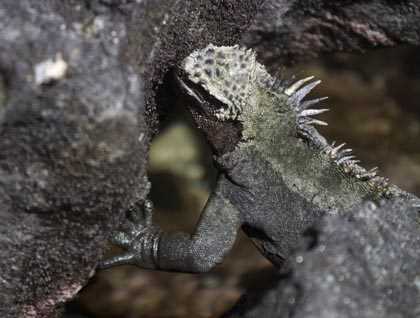This morning we woke up in the northern most part of Isabela Island, where cold water rises to the surface, bringing up water rich in nutrients. This is the main reason why this place has the largest marine iguanas found in the Galápagos and 70 percent of the total Galápagos penguin population. It also has the total population of the Galápagos flightless cormorants and one of the largest Pacific green sea turtles aggregations as well. These are just a few of the amazing facts found in this corner of the world.
Early this morning we experienced an amazing phenomenon, which is typical for this time of the year, when water from the ocean surface evaporates and encounters cold winds causing a condensation known as an inversion layer. For 30 minutes, most of the islands in the surrounding area disappeared behind this fog. No wonder the Galápagos is nicknamed the Enchanted Archipelago.
Later on, we had the privilege of disembarking on Fernandina Island. This volcano is considered to be a pristine place. Unlike the other islands, it was never impacted by introduced animals. Its landscape is completely black with little vegetation because volcanic activity takes place from time to time. From a distance, it looks so barren and deserted but close up there are thousands of marine iguanas basking along the coastline. We also spotted Galápagos flightless cormorants, turtles, boobies, pelicans, and migratory shore birds.
After two hours navigation over lunch, we arrived at a new location, Punta Vicente Roca. Here, our guests could choose between two options. The first one was a Zodiac ride along a dramatic geological formation, followed by snorkeling. The other option was to explore the visitor site, a prime location for observing turtles, penguins, cormorants, boobies, terns and many other interesting sightings.
We finished our day crossing the equatorial line onboard the National Geographic Endeavour. The light couldn’t be better because we had a beautiful sunset right as we crossed the equator.







